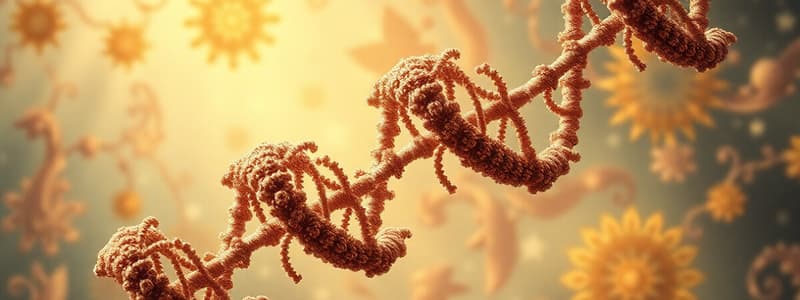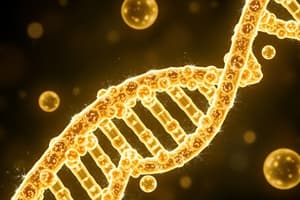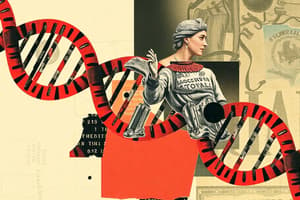Podcast
Questions and Answers
What is the primary function of DNA polymerase III during DNA replication?
What is the primary function of DNA polymerase III during DNA replication?
- Removes RNA primers from the lagging strand
- Synthesizes the leading strand only
- Extends the new DNA strand in both leading and lagging strands (correct)
- Joins Okazaki fragments together
Which characteristic differentiates the leading strand from the lagging strand during DNA replication?
Which characteristic differentiates the leading strand from the lagging strand during DNA replication?
- The leading strand is synthesized in the 5' to 3' direction
- The leading strand requires multiple primers
- The lagging strand is continuously synthesized
- The lagging strand creates Okazaki fragments (correct)
What is the role of DNA ligase in DNA replication?
What is the role of DNA ligase in DNA replication?
- To synthesize new DNA strands
- To act as a primer for DNA synthesis
- To fill gaps left after RNA primer removal
- To join Okazaki fragments by fixing single-strand nicks (correct)
What distinguishes DNA polymerase I from DNA polymerase III?
What distinguishes DNA polymerase I from DNA polymerase III?
What happens during the removal of RNA primers in DNA replication?
What happens during the removal of RNA primers in DNA replication?
What technique did Maurice Wilkins and Rosalind Franklin use to study the molecular structure of DNA?
What technique did Maurice Wilkins and Rosalind Franklin use to study the molecular structure of DNA?
What significant discovery did Franklin make regarding the structure of DNA?
What significant discovery did Franklin make regarding the structure of DNA?
How did Watson and Crick first misinterpret the base pairing in DNA?
How did Watson and Crick first misinterpret the base pairing in DNA?
What is the significance of the spacing of the nitrogenous bases in the DNA structure?
What is the significance of the spacing of the nitrogenous bases in the DNA structure?
What does the semiconservative model of DNA replication predict?
What does the semiconservative model of DNA replication predict?
Chargaff's rule states that adenine pairs with which nitrogenous base?
Chargaff's rule states that adenine pairs with which nitrogenous base?
What was one of the first things Watson and Crick deduced from Franklin's X-ray images?
What was one of the first things Watson and Crick deduced from Franklin's X-ray images?
What is the primary function of DNA polymerase during DNA replication?
What is the primary function of DNA polymerase during DNA replication?
What are telomeres primarily responsible for in linear DNA molecules?
What are telomeres primarily responsible for in linear DNA molecules?
What is true about the strands of DNA in relation to each other?
What is true about the strands of DNA in relation to each other?
What mechanism is primarily utilized to correct mismatched nucleotides after DNA synthesis?
What mechanism is primarily utilized to correct mismatched nucleotides after DNA synthesis?
How often do errors occur in completed DNA molecules despite proofreading?
How often do errors occur in completed DNA molecules despite proofreading?
What is the significance of mutations in DNA?
What is the significance of mutations in DNA?
What is the primary function of histones in chromatin?
What is the primary function of histones in chromatin?
What distinguishes heterochromatin from euchromatin?
What distinguishes heterochromatin from euchromatin?
How does the modification of histones influence gene activity?
How does the modification of histones influence gene activity?
What role does the scaffold play in chromatin structure?
What role does the scaffold play in chromatin structure?
During which phase of the cell cycle do chromosomes fully condense into mitotic chromosomes?
During which phase of the cell cycle do chromosomes fully condense into mitotic chromosomes?
What role does primase play in DNA replication?
What role does primase play in DNA replication?
Which statement is true regarding DNA polymerase activity?
Which statement is true regarding DNA polymerase activity?
In which direction do DNA polymerases synthesize new DNA strands?
In which direction do DNA polymerases synthesize new DNA strands?
What characterizes the lagging strand during DNA replication?
What characterizes the lagging strand during DNA replication?
What distinguishes dATP from ATP in nucleotide synthesis?
What distinguishes dATP from ATP in nucleotide synthesis?
How long are Okazaki fragments typically in eukaryotic cells?
How long are Okazaki fragments typically in eukaryotic cells?
Why is the primer crucial for DNA synthesis?
Why is the primer crucial for DNA synthesis?
What is the rate of DNA elongation in human cells compared to bacteria?
What is the rate of DNA elongation in human cells compared to bacteria?
What is the role of helicases in DNA replication?
What is the role of helicases in DNA replication?
Which statement is true regarding the speed of DNA replication in prokaryotes versus eukaryotes?
Which statement is true regarding the speed of DNA replication in prokaryotes versus eukaryotes?
What is the function of topoisomerase in the DNA replication process?
What is the function of topoisomerase in the DNA replication process?
Why is a primer necessary for DNA polymerase to begin synthesis?
Why is a primer necessary for DNA polymerase to begin synthesis?
What is one characteristic of DNA topoisomerase I?
What is one characteristic of DNA topoisomerase I?
What is the primary role of Taq polymerase in the PCR process?
What is the primary role of Taq polymerase in the PCR process?
Which step of the PCR process occurs at a temperature of 94-95°C?
Which step of the PCR process occurs at a temperature of 94-95°C?
Which statement about DNA sequencing is true?
Which statement about DNA sequencing is true?
How does PCR facilitate gene cloning?
How does PCR facilitate gene cloning?
What distinctive feature does third-generation sequencing offer compared to earlier techniques?
What distinctive feature does third-generation sequencing offer compared to earlier techniques?
What is the purpose of nucleic acid hybridization in genetic engineering?
What is the purpose of nucleic acid hybridization in genetic engineering?
What is formed when a plasmid incorporates foreign DNA?
What is formed when a plasmid incorporates foreign DNA?
How do restriction enzymes contribute to the process of recombinant DNA technology?
How do restriction enzymes contribute to the process of recombinant DNA technology?
What is the result of using gel electrophoresis in DNA analysis?
What is the result of using gel electrophoresis in DNA analysis?
What is the main purpose of gene cloning?
What is the main purpose of gene cloning?
What is the primary function of the Cas9 enzyme in the CRISPR-Cas9 system?
What is the primary function of the Cas9 enzyme in the CRISPR-Cas9 system?
What is the purpose of using the CRISPR-Cas9 system to 'knock out' a gene?
What is the purpose of using the CRISPR-Cas9 system to 'knock out' a gene?
In the context of gene drive technology, what is the significance of engineering a new allele to favor its inheritance?
In the context of gene drive technology, what is the significance of engineering a new allele to favor its inheritance?
What concern does Jennifer Doudna highlight regarding the CRISPR technology?
What concern does Jennifer Doudna highlight regarding the CRISPR technology?
In what way has CRISPR technology been applied to address sickle-cell disease?
In what way has CRISPR technology been applied to address sickle-cell disease?
What is the primary role of single-stranded binding proteins during DNA replication?
What is the primary role of single-stranded binding proteins during DNA replication?
Which sequence correctly identifies the steps involved in synthesizing the lagging strand?
Which sequence correctly identifies the steps involved in synthesizing the lagging strand?
What characterizes a bacterial chromosome compared to a eukaryotic chromosome?
What characterizes a bacterial chromosome compared to a eukaryotic chromosome?
Which of these enzymes is involved in replacing RNA primers with DNA nucleotides?
Which of these enzymes is involved in replacing RNA primers with DNA nucleotides?
What occurs after DNA polymerase III synthesizes fragment 4 during DNA replication?
What occurs after DNA polymerase III synthesizes fragment 4 during DNA replication?
Flashcards
Primase role
Primase role
Primase is an RNA polymerase that creates short RNA segments called primers, necessary for DNA replication initiation.
Primer function
Primer function
Primers are short RNA segments that provide a 3' end for DNA polymerase to initiate adding DNA nucleotides during replication.
DNA polymerase
DNA polymerase
Enzymes that add nucleotides to a growing DNA strand, along a template, from the 5' to 3' end of the new strand.
Leading strand synthesis
Leading strand synthesis
Signup and view all the flashcards
Lagging strand synthesis
Lagging strand synthesis
Signup and view all the flashcards
Okazaki fragments
Okazaki fragments
Signup and view all the flashcards
Antiparallel elongation
Antiparallel elongation
Signup and view all the flashcards
DNA Replication initiation
DNA Replication initiation
Signup and view all the flashcards
Deoxynucleotide Triphosphates (dNTPs)
Deoxynucleotide Triphosphates (dNTPs)
Signup and view all the flashcards
X-ray crystallography
X-ray crystallography
Signup and view all the flashcards
DNA structure
DNA structure
Signup and view all the flashcards
Base pairing
Base pairing
Signup and view all the flashcards
Antiparallel strands
Antiparallel strands
Signup and view all the flashcards
Semiconservative replication
Semiconservative replication
Signup and view all the flashcards
Chargaff's rule
Chargaff's rule
Signup and view all the flashcards
DNA replication
DNA replication
Signup and view all the flashcards
Purine base
Purine base
Signup and view all the flashcards
Pyrimidine base
Pyrimidine base
Signup and view all the flashcards
DNA Replication Machine
DNA Replication Machine
Signup and view all the flashcards
Trombone Model
Trombone Model
Signup and view all the flashcards
DNA Polymerase Proofreading
DNA Polymerase Proofreading
Signup and view all the flashcards
Mismatch Repair
Mismatch Repair
Signup and view all the flashcards
Nucleotide Excision Repair
Nucleotide Excision Repair
Signup and view all the flashcards
Mutations, Source of Genetic Variation
Mutations, Source of Genetic Variation
Signup and view all the flashcards
Telomeres
Telomeres
Signup and view all the flashcards
Telomere Shortening and Cellular Aging
Telomere Shortening and Cellular Aging
Signup and view all the flashcards
Telomere's RNA Template
Telomere's RNA Template
Signup and view all the flashcards
Telomere's Cancer link
Telomere's Cancer link
Signup and view all the flashcards
DNA Replication Synthesis Direction
DNA Replication Synthesis Direction
Signup and view all the flashcards
Leading Strand Synthesis
Leading Strand Synthesis
Signup and view all the flashcards
Lagging Strand Synthesis
Lagging Strand Synthesis
Signup and view all the flashcards
Okazaki Fragments
Okazaki Fragments
Signup and view all the flashcards
Primer Role in DNA Replication
Primer Role in DNA Replication
Signup and view all the flashcards
DNA Polymerase III prokaryotes
DNA Polymerase III prokaryotes
Signup and view all the flashcards
DNA Polymerase I role
DNA Polymerase I role
Signup and view all the flashcards
RNA/DNA Heteroduplex
RNA/DNA Heteroduplex
Signup and view all the flashcards
5' to 3' exonuclease activity
5' to 3' exonuclease activity
Signup and view all the flashcards
5' to 3' polymerase activity
5' to 3' polymerase activity
Signup and view all the flashcards
DNA Ligase
DNA Ligase
Signup and view all the flashcards
DNA Ligase Limitations
DNA Ligase Limitations
Signup and view all the flashcards
DNA Replication Speed
DNA Replication Speed
Signup and view all the flashcards
Origins of Replication
Origins of Replication
Signup and view all the flashcards
Replication Fork
Replication Fork
Signup and view all the flashcards
Helicases
Helicases
Signup and view all the flashcards
Single-stranded Binding Proteins
Single-stranded Binding Proteins
Signup and view all the flashcards
Topoisomerase
Topoisomerase
Signup and view all the flashcards
DNA Polymerase's Requirement
DNA Polymerase's Requirement
Signup and view all the flashcards
Primase
Primase
Signup and view all the flashcards
Chromatin
Chromatin
Signup and view all the flashcards
Histones
Histones
Signup and view all the flashcards
Nucleosome
Nucleosome
Signup and view all the flashcards
Heterochromatin
Heterochromatin
Signup and view all the flashcards
Euchromatin
Euchromatin
Signup and view all the flashcards
30 nm fiber
30 nm fiber
Signup and view all the flashcards
Histone modification
Histone modification
Signup and view all the flashcards
Methylation
Methylation
Signup and view all the flashcards
Acetylation
Acetylation
Signup and view all the flashcards
Chromosome condensation
Chromosome condensation
Signup and view all the flashcards
Metaphase chromosome
Metaphase chromosome
Signup and view all the flashcards
CRISPR-Cas9 system
CRISPR-Cas9 system
Signup and view all the flashcards
Gene knockout
Gene knockout
Signup and view all the flashcards
Gene drive
Gene drive
Signup and view all the flashcards
Sickle-cell disease
Sickle-cell disease
Signup and view all the flashcards
Insect-borne diseases
Insect-borne diseases
Signup and view all the flashcards
Ethical considerations
Ethical considerations
Signup and view all the flashcards
PCR
PCR
Signup and view all the flashcards
PCR Cycle
PCR Cycle
Signup and view all the flashcards
Taq Polymerase
Taq Polymerase
Signup and view all the flashcards
Denaturation (PCR)
Denaturation (PCR)
Signup and view all the flashcards
Annealing (PCR)
Annealing (PCR)
Signup and view all the flashcards
Extension (PCR)
Extension (PCR)
Signup and view all the flashcards
DNA Sequencing
DNA Sequencing
Signup and view all the flashcards
Sanger Sequencing
Sanger Sequencing
Signup and view all the flashcards
Next-generation sequencing
Next-generation sequencing
Signup and view all the flashcards
Nanopore sequencing
Nanopore sequencing
Signup and view all the flashcards
Nucleic acid hybridization
Nucleic acid hybridization
Signup and view all the flashcards
DNA cloning
DNA cloning
Signup and view all the flashcards
Plasmid
Plasmid
Signup and view all the flashcards
Recombinant DNA
Recombinant DNA
Signup and view all the flashcards
Gene cloning
Gene cloning
Signup and view all the flashcards
Cloning vector
Cloning vector
Signup and view all the flashcards
Restriction enzymes
Restriction enzymes
Signup and view all the flashcards
Restriction sites
Restriction sites
Signup and view all the flashcards
Restriction fragments
Restriction fragments
Signup and view all the flashcards
Sticky ends
Sticky ends
Signup and view all the flashcards
DNA ligase
DNA ligase
Signup and view all the flashcards
Gel electrophoresis
Gel electrophoresis
Signup and view all the flashcards
DNA Replication
DNA Replication
Signup and view all the flashcards
Helicase
Helicase
Signup and view all the flashcards
SSBP
SSBP
Signup and view all the flashcards
Leading Strand
Leading Strand
Signup and view all the flashcards
Lagging Strand
Lagging Strand
Signup and view all the flashcards
Okazaki fragments
Okazaki fragments
Signup and view all the flashcards
DNA polymerase III
DNA polymerase III
Signup and view all the flashcards
DNA polymerase I
DNA polymerase I
Signup and view all the flashcards
DNA ligase
DNA ligase
Signup and view all the flashcards
Bacterial Chromosome
Bacterial Chromosome
Signup and view all the flashcards
Eukaryotic Chromosome
Eukaryotic Chromosome
Signup and view all the flashcards
Supercoiling
Supercoiling
Signup and view all the flashcards



